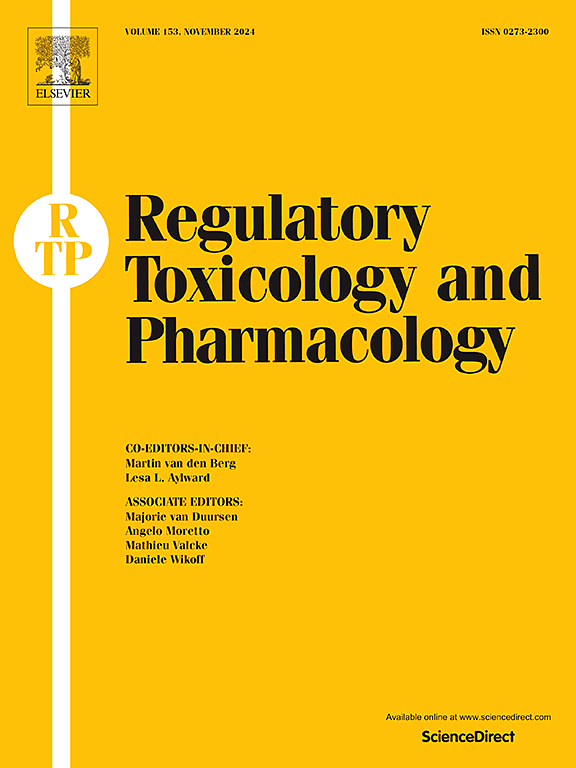叔丁醇对雌性小鼠甲状腺滤泡细胞腺瘤抗甲状腺作用模式的评价。
IF 3.5
4区 医学
Q1 MEDICINE, LEGAL
引用次数: 0
摘要
在雌性小鼠中,长期暴露于饮用水(DW)中的叔丁醇(TBA)与甲状腺滤泡细胞腺瘤的发生率低但增加有关(15%对3%)。美国环境保护署在抗甲状腺(AT)作用模式(MOA)的背景下评估了这些数据,并发现了数据缺口,同时指出甲状腺腺瘤的证据“具有启发性”。一项研究旨在解决TBA甲状腺肿瘤MOA的数据缺口。雌性小鼠通过灌胃(500或1000 mg/kg)或DW (5-40 mg/mL)暴露于TBA 5天,最长可达28天。TBA激活了AT MOA框架内的上游关键事件(KEs),包括CAR/PXR信号和UGT和SULT转录本的上调。然而,未观察到UGT和SULT活性增加。下游事件(2年前血清TSH和甲状腺组织病理学下降)未被证实。无法证明下游KEs可能是慢性暴露于TBA的弱肿瘤反应的结果。根据先前发表的数据,AT MOA是对TBA肿瘤弱反应的合理解释,分析强调了对弱的、提示性的肿瘤数据进行风险评估的重要后果。本文章由计算机程序翻译,如有差异,请以英文原文为准。
Evaluation of an anti-thyroid mode of action for thyroid follicular cell adenomas in female mice exposed to tertiary butyl alcohol
Chronic exposure to tertiary butyl alcohol (TBA) in drinking water (DW) is associated with low but increased incidence (15 % vs 3 % in controls) of thyroid follicular cell adenomas in female mice. The U.S. Environmental Protection Agency evaluated this data in the context of an anti-thyroid mode of action (MOA) and identified data gaps while noting evidence for thyroid adenomas as “suggestive”. A study was designed to address data gaps in the MOA for TBA thyroid tumors. Female mice were exposed for 5 days to TBA by oral gavage (500 or 1000 mg/kg) or via DW (5–40 mg/mL) for up to 28 days. TBA activated upstream key events (KEs) within the anti-thyroid MOA framework including CAR/PXR signaling and upregulation of UGT and SULT transcripts. However, increased UGT and SULT activity was not observed. Downstream events (decreased serum TSH and thyroid histopathology prior to 2-years) were not demonstrated. The inability to demonstrate downstream KEs is likely a consequence of a weak tumor response with chronic exposure to TBA. With previously published data, an anti-thyroid MOA is a plausible explanation for a weak TBA tumor response, with analysis highlighting important consequences of conducting risk assessments on weak, suggestive tumor data.
求助全文
通过发布文献求助,成功后即可免费获取论文全文。
去求助
来源期刊
CiteScore
6.70
自引率
8.80%
发文量
147
审稿时长
58 days
期刊介绍:
Regulatory Toxicology and Pharmacology publishes peer reviewed articles that involve the generation, evaluation, and interpretation of experimental animal and human data that are of direct importance and relevance for regulatory authorities with respect to toxicological and pharmacological regulations in society. All peer-reviewed articles that are published should be devoted to improve the protection of human health and environment. Reviews and discussions are welcomed that address legal and/or regulatory decisions with respect to risk assessment and management of toxicological and pharmacological compounds on a scientific basis. It addresses an international readership of scientists, risk assessors and managers, and other professionals active in the field of human and environmental health.
Types of peer-reviewed articles published:
-Original research articles of relevance for regulatory aspects covering aspects including, but not limited to:
1.Factors influencing human sensitivity
2.Exposure science related to risk assessment
3.Alternative toxicological test methods
4.Frameworks for evaluation and integration of data in regulatory evaluations
5.Harmonization across regulatory agencies
6.Read-across methods and evaluations
-Contemporary Reviews on policy related Research issues
-Letters to the Editor
-Guest Editorials (by Invitation)

 求助内容:
求助内容: 应助结果提醒方式:
应助结果提醒方式:


